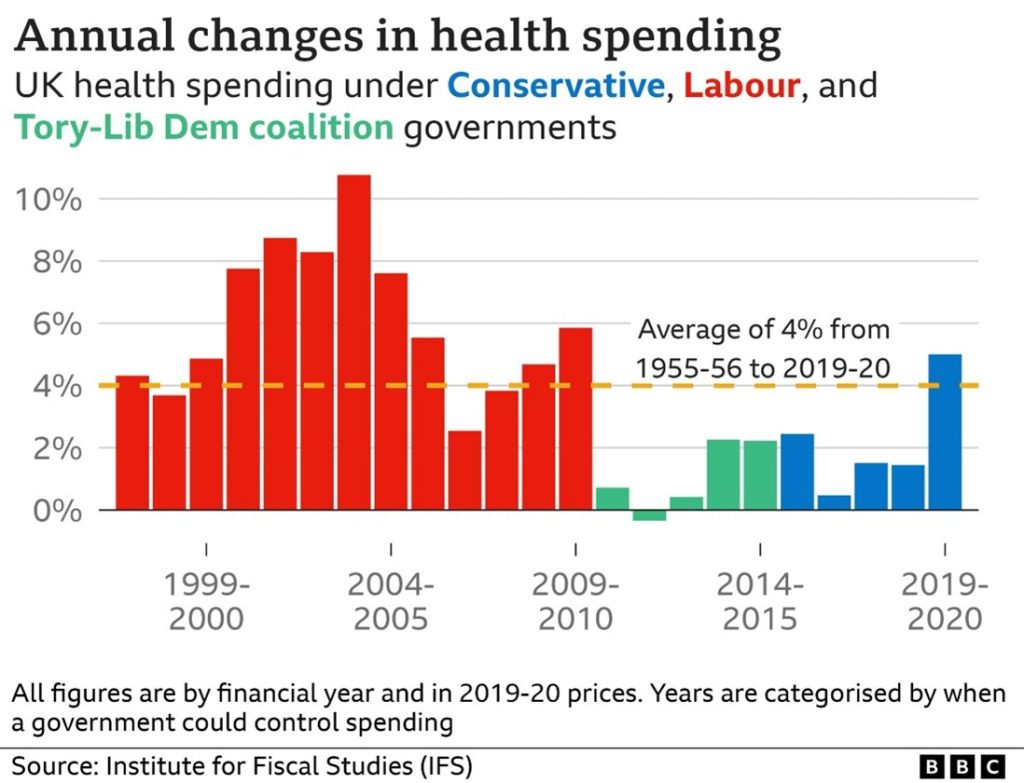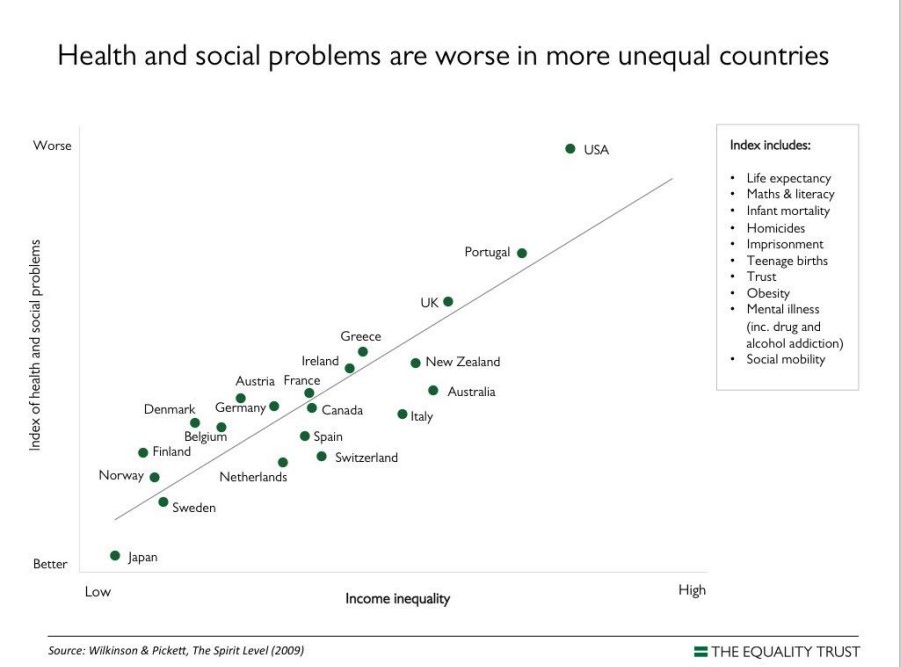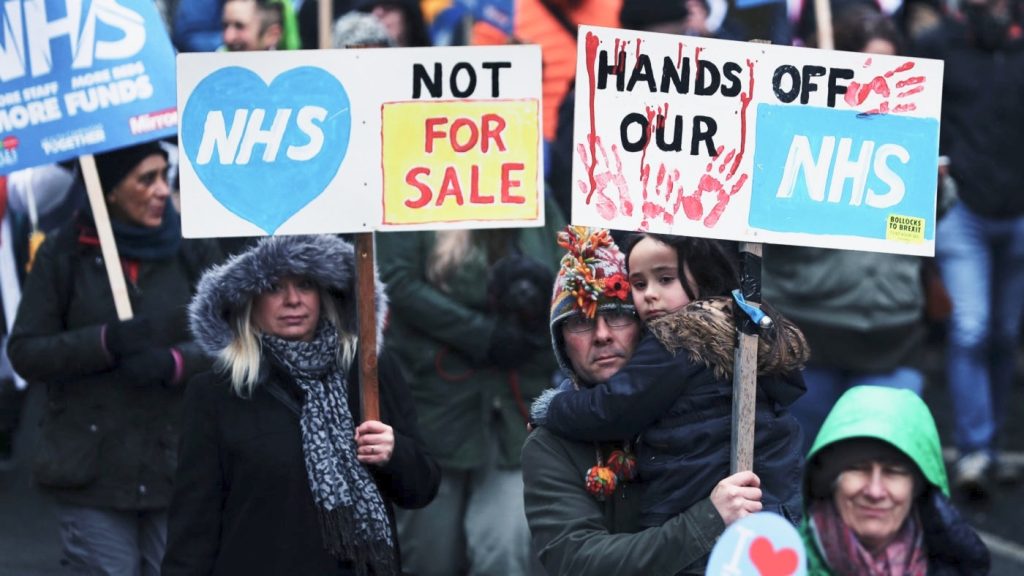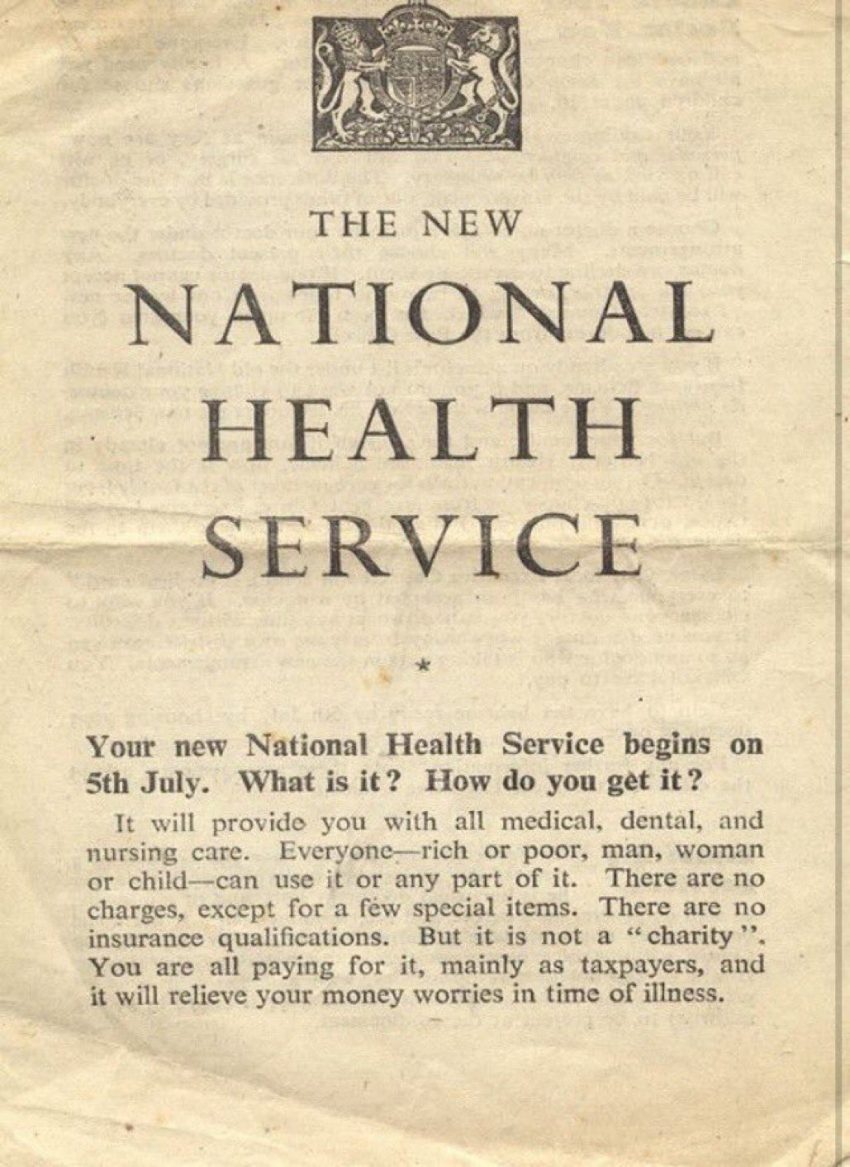The coincidence of the 75th “birthday” of the NHS with acute public awareness of ways in which our health system is currently under stress has pushed the issue of healthcare up the political agenda and prompted a wide range of reflection on what the future holds. Millions are on waiting lists or long-term sick.
In 2010 the “Commonwealth Fund” found, in its “International Health Policy Survey in Eleven Countries”, that British citizens were the most confident they would receive the best medical care if sick, most confident that they would be able to afford any healthcare required, least worried about the amount of time it would take to get a diagnosis and second most satisfied with the quality of any care they had actually received.
We could, of course, have been deluding ourselves. It was known, for instance, that some of our care outcomes were not always the best. In a subsequent study covering 2016, the Fund, however, still found that the NHS ranked first overall, even if it was the second worst performer for “care outcomes”. Even on this last point, though, it noted that the NHS was improving more rapidly that its comparators. “In the early 2000s, the U.K. made a major investment in its National Health Service, reforming primary care and cancer care in addition to increasing health care spending from 6.2 percent of GDP in 2000 to 9.9 percent of GDP in 2014….The reforms and increased spending may have contributed to the rapid decline in mortality amenable to health care in the U.K“.
The recent King’s Fund study “How does the NHS compare to the health care systems of other countries?” found: “Waiting times in the UK for common procedures like knee, hip and cataract operations were broadly ‘middle of the pack’ compared to peer countries in 2019 – before the Covid-19 pandemic. But the fall in activity for these procedures in the first year of the pandemic was dramatically sharper in the UK than in peer countries” – showing, perhaps, how “close to the edge” the NHS was running by 2019.
It also found that “The UK performs substantially less well than its peers – and is more of a laggard than a leader – on many measures of health status and health care outcomes. These include health outcomes that can be heavily affected by the actions of a health system (such as surviving cancer), and outcomes such as life expectancy, which are significantly affected by factors beyond the direct control of any health system“.
The King’s Fund Report puts a finger on the fact that no one has identified why Britain seems to struggle with care outcomes: “Data on health outcomes can be heavily affected by differences in how countries record and report that data, and factors outside the control of a health care system. Looking at aggregated ‘point-in-time’ measures can also mask wider trends, such as the UK closing the gap on other countries in survival rates for breast cancer (for example). And comparable data is not available for the full range of conditions and diseases that afflict the populations of our basket of countries. But even with these caveats in mind, it is striking that the UK performs poorly on health care outcomes across several different major disease groups and health conditions. Even when it came top of The Commonwealth Fund’s ranking of health systems in 2014 it was notable that then, as now, the UK health system performed poorly on measures of health care outcomes”.
Factors outside the control of health systems include the general health of the population, which is hard to measure and compare. As we note below, social features like inequality can have a health impact. Though there does not seem to be a clear correlation between the GINI coefficient and care outcomes, it is notable that the two worst performers here are Britain and America. One thing that does seem to stand out regarding the NHS is its provision of fewer doctors and nurses per patient than other systems. Spending per patient has also seen a serious dip.

In their study published October 2019, “Performance of UK National Health Service compared with other high income countries“, Irene Papanicolas et al. found a mixed picture in respect of care outcomes: “The UK had the lowest rates of unmet need and among the lowest numbers of doctors and nurses per capita, despite having average levels of utilisation (number of hospital admissions). The UK had slightly below average life expectancy (81.3 years compared with a mean of 81.7) and cancer survival, including breast, cervical, colon, and rectal cancer. Although several health service outcomes were poor, such as postoperative sepsis after abdominal surgery (UK 2454 per 100000 discharges; mean 2058 per 100000 discharges), 30 day mortality for acute myocardial infarction (UK 7.1%; mean 5.5%), and ischaemic stroke (UK 9.6%; mean 6.6%), the UK achieved lower than average rates of postoperative deep venous thrombosis after joint surgery and fewer healthcare associated infections”.
This study noted that “The UK’s spending on healthcare has been constrained for some time, with slow growth in spending in a setting of steadily increasing demand as the population ages and other safety nets for the older population are cut. From 2010 to 2017, the number of people aged over 80 rose by 340000. In the same period, real public spending on social care fell by 1% and spending on adult social care fell by 6.4%”.
It also reported that there was a perception that quality of care was going down: “44% of UK adults reported that they thought the healthcare system worked well (compared with the study average of 45%), although this had declined by 19 percentage points since 2010”. “The number of primary care physicians reporting that the system worked well in 2015 had decreased by 24 percentage points from 2012, compared with a mean change of 8 percentage points across all 10 countries”.
What was already beginning to show, in fact, was that spending on the NHS was no longer being maintained at the levels which had previously applied. From 2000 onwards the NHS budget had risen by an average of 4% above inflation each year. But since 2010, the average annual rate of increase became half that.

By the end of 2019 NHS Providers Chief Executive Chris Hopson calculated that if NHS spending since David Cameron first took office had just kept pace with the previous long term average annual increase, spending on health and social care would by then have been £35 billion per year higher than it was.
Government spending on healthcare was £30.5bn lower a year than the EU14 average from 2010-2019 (Health Foundation report: “How does UK health spending compare across Europe over the past decade?”/OECD 2022)
Writing for “The Lowdown” on 28th June 2021, Martin Shelley noted that the Service, even before taking the hit of the COVID pandemic, faced a capacity crisis, and a staffing crisis.“…..the number of beds was already at an all-time low in the months leading up to the pandemic, with more than 17,000 having been cut from the health service’s stock of almost 145,000 that was available in 2010, when the Tory-dominated coalition government initiated a nine-year funding squeeze”. “A Nuffield Trust study conducted before the pandemic took hold found that long-term under-investment had already placed the UK firmly near the bottom of a 31-country league table for health resources. It came in 29th for its stock of hospital beds – with only 2.5 beds per 1,000 people, compared to 8 per 1,000 in Germany”.
“Staff shortages remain a historic problem for the NHS too, with an estimated 85,000 vacancies remaining in England from before the pandemic, and a further 112,000 unfilled posts in social care”.
There are several factors behind this shortage of staff:
- lack of long-term planning by the government, which means not enough staff being trained over the past decade or more;
- removal of the nursing and other bursaries (never fully reversed);
- low pay and for some staff a pay cut;
- brexit leading to a loss of staff from the EU and a reduction in staff coming from EU countries.
Dr Julia Patterson, in her recent book “Critical” also suggests the more unmeasurable feature that (p.56) “There were many instances where staffing shortages occurred, and because the doctors ‘coped’, little effort would be put into recruiting staff into the team gaps that created these situations”.
There consequently developed a vicious cycle, where downward pressures on staffing and pay have themselves worsened the staffing problem. “Nursing Notes” in August 2022 reported:
“New research by Florence reveals that a staggering 16% of health and social care workers are looking to totally leave the industry, while nearly half (43%) are actively looking for a new job. The study also found that almost a third of healthcare workers (28%) admit to feeling overwhelmed at least once a week, with 17% feeling burnt out every day.Half of the health and social care workers surveyed cited not having enough staff as the biggest pressure they face, followed by low pay (39%) and high workload (35%)”.
The NHS confronted the COVID pandemic with an already understaffed workforce.

A further consequence of recent funding is that the NHS “maintenance backlog” has grown like topsy. According to the Nuffield Trust in November 2022: “Since 2004, the cost of fixing the backlog of maintenance – everything from leaky gutters to faulty lifts and the very fabric of hospital buildings – in the NHS in England has risen: from £4.5 billion to £10.2 billion in 2022 in real terms. This is an increase of 130%, and now represents 92% of the entire annual running costs for the whole of the NHS estate – and is a billion pounds more than the total capital spending plan for 2021/22”

With the caveat that we should be seeing more work done on the question of care outcomes, it does seem to us that the evidence suggests the NHS is basically a sound system, but one that is sensitive to variations in its funding. Looking at its performance over time it is the correlation of problems with funding changes that stands out. Fund it well and it performs better. Under-fund it and problems emerge.
Governments since 2010 have had a bad impact on the NHS by “underfunding it”.
“You can’t cut things back forever and expect the service to remain the same, expect the staff to keep absorbing more and more. There’s a tipping point. Over time, the situation becomes intolerable, and things break”.
Dr Julia Grace Patterson “Critcal” Mudlark Press 2023
Simultaneously, though, they have tried to escape this basic reality with claims that “reforms” can deal with spending pressures by getting improved “efficiency”. Or, another way of looking at it is that to the funding crisis they have also added further problems related to increasing fragmentation and “privatisation” going back to the innovation of the “internal market”, first floated in the White Paper Working for Patients in 1989.
The “Commonwealth Fund” comparisons mentioned above gave the USA the lowest overall ranking, and the lowest ranking in the specific areas of care outcomes, access and equity. So you’d think that it would be the last place anyone would look for inspiration. But no. Over the last decade or so it is to people with American experience that British Governments have turned for help.
Simon Stevens, was appointed by David Cameron to Director of NHS England because ‘he knows more about NHS problems and market solutions than any man alive.’ In his previous role as a CEO of United Health, Stevens had led corporate opposition to the introduction of Obamacare. His ‘Five-Year Forward View’, launched in 2015, became the basis for NHS England’s Sustainability and Transformation Plans (STPs), drawn up with help from Optum – an American healthcare services provider with business interests encompassing technology and related services, pharmacy care services and various direct healthcare services – and McKinsey, the “global consultancy”.
Opinions differ as to whether one can reasonably talk about a “stealth Americanisation” of the NHS. It is maybe significant that the “Economist” (27/05/23), whilst saying that “spending more money cannot be the only answer”, pulled back from advocating “fundamental reform” – “…meta-analyses suggest that there is no relationship between a county’s choice of funding system and its health outcomes…all health systems have their own challenges”.
“A recent survey by Ipsos…found that 90% of Britons believe the NHS should be free at the point of delivery, and 84% think the NHS should be funded primarily through taxation…Trying to switch to a new model would be ‘like throwing stones at Everest’, says Alastair McLellan, who edits the Health Service Journal….’The NHS is a fixed fact. Clever policymakers work with that, not against it’..”.
Nevertheless, what does seem clear is that the current strategic approach is to try and “counterbalance” underfunding through three measures. The first is to place greater emphasis on preventative, primary and community care, to try to reduce the numbers of people presenting into the hospital sector at all. The second is to continue to push for greater “centralisation” and concentration of services. And the third is to make increased use of “Independent Service Providers” (ISPs) as part of a sort of contractual mosaic – the idea being that it does not matter who does the job so long as the principle of free access is maintained; ie. greater “privatisation” in the same sense that the term has applied to outsourcing in other parts of the public sector.
Paying attention to the general “health of the population” is not a bad idea in itself, and it is indeed something that should also be taken into account when looking at comparative “care outcomes”. We have to be careful, though, that it does not degenerate into simply a question of “putting people off”.
Somewhat ironically, it is arguable it is the degree of inequality we tolerate in British society that has significant negative feedback here. Richard Wilkinson and Kate Pickett argued in their book “The Spirit Level”, in 2009, that adverse health measures within populations correlated with their relative inequality: more adults are obese in more unequal countries, more people suffer from mental illnesses in more unequal countries, the use of illegal drugs is more common in more unequal countries. The UK is one of the more unequal industrialised societies and consequently tends to score highly in respect of these “ills of inequality”. The “Centre for Ageing Better” commented in its 2017 Report “Inequalities in later life”: “Across a range of measures, robust evidence exists of the strong association between socio-economic status and inequalities in life expectancy, healthy life expectancy and disability free life expectancy. The most advantaged groups tend to live longer in better health and without functional impairment than those who experience poverty and disadvantage. The same pattern is also reflected when specific health conditions are considered. Depending on the condition, inequalities in survival also relate closely to a person’s age, sex and ethnicity. Evidence suggests that people’s perceptions of their social status and their future life expectancy relate to their actual chances of survival”.

Often conditions that have a correlation with inequality have their impact on some NHS services amplified by also being areas where there are concerns about current levels of Health and Social Care provision. In its 2019 Report “Mental Health: our Position” the King’s Fund noted that “Historical underinvestment and cuts to funding have impacted on access to services and quality of care delivered by providers of mental health services. Increases in funding have often been attached to individual programmes, fragmenting services and leaving core services without the investment they need. Despite repeated commitments to increase funding, it has been difficult to track whether this money has reached frontline services”. They also pointed out that “A more integrated approach to physical and mental health is needed to provide joined-up services to the significant numbers of people experiencing mental health problems alongside long-term physical health problems, and to address inequalities in life expectancy among people with serious mental illness. This includes embedding mental health expertise across all health and care services and addressing the physical health of people with mental health conditions“.
A November 2021 Report from the Red Cross “Nowhere Else To Turn” found a “clear link between high intensity use” (of A&E and Ambulance Services) “and wider inequalities. High intensity use is greatest in areas of deprivation, and across all age groups it is associated with issues such as homelessness, being out of work, mental health conditions, drug and alcohol problems, criminality, and loneliness and social isolation. And we know that people who attend A&E frequently are significantly more likely to die than people who don’t attend so frequently”.
Service reconfigurations associated with centralisation and specialisation are particularly likely to become “flashpoints”. Locally, for instance, Emergency Services have been re-shaped over recent years with Royal Blackburn becoming the “blue light” destination, Burnley an Urgent Care Centre and Accrington a Minor Injury Unit. The “downgrading” of facilities at both Burnley and Accrington provoked local campaigns – and a sense of getting a reduced service persisted: see Campaigners look back on ten years since the closure of Burnley General Teaching Hospital’s A&E department | Lancashire Telegraph. Sometimes one can get the wrong end of the stick from simply reading Board papers, but when one looks at the Corporate Risk Register received at ELHT as Agenda Item 10 on 11/01/23 – “At times of extreme pressure, increasing patient numbers across the emergency pathway makes the provision of care difficult, impacts on clinical flow, increases the risk of nosocomial infection spread as a result of overcrowding and poor patient experience leading to complaints” – one is entitled to ask how well the reconfiguration has gone and why the public should have confidence in any similar future plans.
Is it fair to say that NHS managers commit to received wisdoms without ever doing much to actually assess whether previous plans really have been a success or not?
Anyone who heard Kevin Lavery, Chief Executive for NHS Lancashire and South Cumbria Integrated Care Board, speak at the Blackburn CVS “TEAM” event in May will have little doubt that further A&E “rationalisation” is on the cards across the ICB footprint.
It is difficult to deal with any proposals fairly, on a case by case basis, when one is aware of a preferred direction of travel lurking in the background. Back in 2013 Sir Bruce Keogh proposed a country-wide reorganisation that would have seen 40-70 “Major Emergency Centres” across the country, backed up by Emergency Centres, backed up by Urgent Care Units. The plan itself was not officially adopted, but one can still sense it retains a degree of influence.
Bhattarai N, McMeekin P, Price C, et al “Economic evaluations on centralisation of specialised healthcare services: a systematic review of methods” (BMJ Open 2016) argued that “It is important to improve the methodology and reporting of economic evaluations in order to provide more robust and transferable evidence. Wider aspects of healthcare centralisation should be considered in the estimates of costs and health outcomes“. The paper was essentially a comparison of studies done, and, if we understand it correctly, it found that there was quite a variation in methodology and in what was considered to be important. Problems identified were the use of “length of stay” as a health outcome measure and that “most of the studies had short-term follow-up, and it is possible that their outcomes would have been different if they had considered longer time frame”.
The increased penetration of Independent Service Providers (ISPs) should maybe be our biggest concern. It seems to be difficult to even pin down how extensive it has become or how quickly it is growing.
According to the British Medical Association Report “NHS outsourcing” (March 2022): “The proportion of spend allocated to non-NHS providers has increased from 8.7% of the DHSC’s RDEL (planned day-to-day health department spend) budget in 2012-13 to 11.1% in 2021-21. While the total DHSC RDEL has not even doubled between 2012-13 to 2020-21 (42% increase), NHS trust spend on outsourcing to ISPs has increased nearly seven-fold, from over £220 million to £1.7 billion, in the same time frame (659% increase)”.
Some specialities are more affected than others: “ISPs have played an increasing role in providing routine NHS-funded procedures such as cataract surgery or hip and knee operations. According to research by the Royal College of Ophthalmologists, in 2021 almost half (46%) of all NHS funded cataract procedures were carried out by the independent sector. By contrast, 11% were delivered in the independent sector just five years prior in 2016. This trend has also been observed across trauma and orthopaedics. In 2016-17, approximately 29% of knee and 20% of hip replacements were delivered by ISPs, up from 20% and 14% respectively in 2012-13”. There is also a particularly noticeable level of involvement in mental health services.
Sian Norris wrote in “Byline Times” on 12/08/2021 that: “In 2019/20, NHS commissioners spent £9.7 billion on services delivered by the private sector – an increase of 14% since 2014/15. In addition, Department of Health and Social Care accounts for 2019/20 show that, if spending with not-for-profit and voluntary providers is taken into account, the spending increases to £14.4 billion – or 10.8% of total revenue spending by the department”.
Meanwhile, a certain proportion of NHS spending goes right through the system like a dose of salts into the pockets of PFI firms. On 30th May 2022 the “New Statesman” reported that “English NHS trusts are spending more than £2bn a year paying back debt on legacy private finance initiative (PFI) projects”.
There are several reasons why we oppose the “privatisation” of the NHS, in this sense, and want to see its “renationalisation” (perhaps a bit of a clumsy expression, but meaning having a positive policy to be biased against outsourcing).

A) We can’t say we haven’t been warned. Almost every time Government has announced that it will increase efficiency, accountability and quality by stimulating the involvement of the private sector in public services the outcome has been lamentable. Do we want the NHS to be the next water industry, energy infrastructure, railway, Probation Service or Royal Mail? If you get rotten fruit from a market stall you don’t go back for more, even for a different type of fruit.
B) Privatisation is easier to get into than away from. We now have the Labour Party telling us that no Government can afford to re-nationalise our energy utilities no matter how much we want them back in public ownership or how much better that would be for us. As outsourcing spreads into a system, ostensibly on a “case by case” basis, it undermines the host’s ability to control it or sustain a capacity not to become reliant on it. Consider Andrew Kersley’s report in “Byline Times” on 31/06/2023 – ” Rewarding Failure: ‘Startling’ Number of Government Outsourcing Firms Not Hitting Minimum Targets”. The article claimed that that around half of the “Strategic Suppliers” assessed failed to hit minimum targets set for them in at least one contract. Despite those problems, they continued to be used for to be managing a significant and growing share of public services. “According to one report by data firm Tussell, they not only receive roughly 11% of public sector spending, but their income from government contracts rose by 24% between 2019-2020 and 2021-2022 alone”. Kersley has elsewhere commented: “Mariana Mazzucato and Rosie Collington’s recent book ‘The Big Con’…..argues that the UK’s growing reliance on private outsourcing and consultants in particular (the UK is second-largest market for consultants globally after the US ) actually strips the government of the ability to run these services itself and leaves the private sector as the default, stable managers of state services in the long-term”.
C) There are existing examples of poor practice – though, to be fair, that can also be said of the NHS. On August 3rd 2022, however, Ben Goodair and Aaron Reeves reported in an LSE Blog that they had attempted to empirically evaluate the impact of outsourced spending to private providers on treatable mortality rates and the quality of health-care services in England and that they had found that in areas with increases in outsourcing there were more deaths of people with treatable conditions. Their work was published in “The Lancet” in July 2022 as “Outsourcing health-care services to the private sector and treatable mortality rates in England, 2013–20: an observational study of NHS privatisation”. It would be wrong to place too much weight on a single study, but it does seem to be flagging up a serious concern.
D) The British Medical Association (BMA) has a clear and long-standing policy opposing outsourcing of NHS frontline clinical services on the basis that greater use of ISPs by the NHS could lead to a decline in standards and poor value for money, as well as fragmentation and destabilisation of services putting staff and patients at risk.
According to their report “NHS Outsourcing” a BMA survey of members identified the following concerns: “…the availability of NHS staff (83%), as a result of the existing limited pool of staff taking on additional work in the independent sector; the funding and sustainability of NHS services (81%) if certain more profitable services are ‘creamed off’; the scope and quality of doctors’ training (81%), given independent sector providers are under no obligation to train staff. There are also concerns around the fair and transparent regulation of ISPs (47%) and the potential for the quality of clinical outcomes for NHS patients to worsen (41%) in ISP settings, which often do not have access to emergency care for example or the resources available in NHS hospitals”.

The BMA says that outsourcing “threatens to undermine NHS planning, finances, and staff training if certain surgeries – namely high volume, low complexity procedures – are no longer performed in the NHS. These concerns have been echoed by nearly 200 ophthalmologists who have warned that plans to outsource more routine procedures (e.g., cataract surgery) to independent hospitals will reduce the number of doctors working in the NHS performing these procedures. This would have significant implications for the future workforce pipeline as a result of the loss of NHS training opportunities in these procedures, with risks for patient safety”.
The BMA consequently supports the view that the NHS should be the default option for NHS services. “This would mean that NHS providers would be the first choice for NHS contracts, with a view to supporting their long-term financial security, the continuity of patient care, and the development of collaborative and integrated models of care”.
We agree. We need emergency funds now. The Government has at last moved towards establishing a “Workforce plan”, but the fear is that this is but one leg of the table. It’s impact on overall funding remains unclear, as is how much it can do to retain staff if pay and other conditions are not improved. We must recruit and retain more frontline staff and pay them properly.
We should be looking at an immediate maintenance and IT programme to improve working conditions and at paying off or annulling the PFI debt.
We should be boosting mental health, substance abuse and social care services to address the key “community” pressures on hospital services. We need to be more aware of the social issues driving health care demand and outcomes. We need to make sure any service reconfigurations are done with appropriate levels of public involvement and are justified by case-specific analyses that are subject to subsequent assessment. And we need to dump outsourcing whilst we still can.

